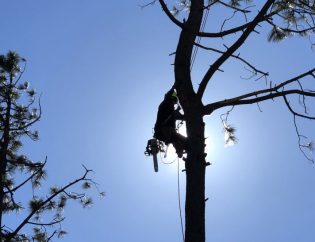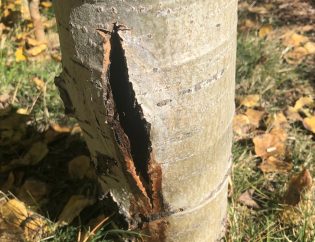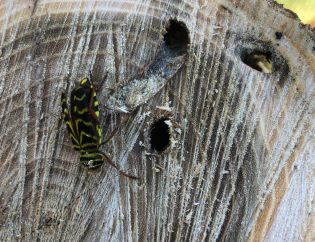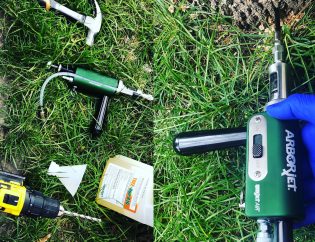Watering Trees During Dry Periods -
Santa Fe Municipal Tree Advisory Board -
As the climate changes and we experience longer growing seasons, hotter temperatures, longer dry spells between rains, and multi-year droughts, it’s increasingly important to insure that your trees have enough water to keep them healthy. Even old established trees that grew acceptably with no irrigation in the past may need to be irrigated in the future. There are many variables involved in knowing how to water trees, including the species, age, size, and health of the tree; the pattern of root spread; soil characteristics; weather patterns; the time of year; and the type of irrigation system. For this reason, these recommendations should be tailored to the trees on your site, based on observations of their responses to weather and watering practices. The goal of irrigation during dry periods is to keep trees from experiencing drought stresses that would harm their growth, not to push them to grow at maximal rates. These recommendations are designed for established trees during periods of inadequate rainfall or below average winter snows.
Where to water
Most of the roots that absorb water are in the top 18-24 inches of soil, so enough water should be applied to saturate at least the top 18 inches of soil at each watering. Where they have enough space to develop, root systems of established trees are often more than twice as wide as the tree is tall; a 20 foot tree can have a root system 40 feet wide, extending far beyond the canopy. Watering only in the area under the tree does not provide water to most of the roots in such a situation. There are few water-absorbing roots next to the trunk, so water should be applied starting 2-3 feet from the trunk and extending out as far as is practical.
How to water
Supplying enough water to saturate the top 18 inches of soil can take a long time; in soils where water sinks in slowly this may require repeated applications over a day or two. Devices that apply water slowly to lessen run-off include drip emitters, soaker hoses, and bubblers (on level ground). Sprinklers are less efficient but can supply water over a large area; those that spray in a low wide pattern are best and should be used in early morning or late afternoon (before 10 a.m. and after 6 p.m.) to minimize evaporation. On slopes, some people install specially-designed root watering tubes and fill these by hand. Building water-catching berms on the downhill side of trees is also useful to catch run-off during rains. To determine how long to water with the system you are using, you should check the depth of penetration after you have watered. A probe for measuring the depth of water penetration can be made with half-inch rebar; a screwdriver with a stout 18 inch blade can also be used. In soils with a silt or clay base, pushing the probe down until it hits hard soil (indicating dryness) will tell you how deep the water has penetrated. In loose sandy soils this may not work as well; you may have to dig down in a few places to determine the depth of saturation. Once you’ve determined how long it takes to wet the soil adequately you can use timers to control the length of watering. You can also find out how much water you’ve used after irrigating thoroughly by checking your water use at Eye on Water (https://www.santafenm.gov/eye_on_water). Water 2 ft from trunk up to 10 ft beyond canopy
When to water
It’s very difficult to determine when to water without checking the moisture level in the soil, either with a probe or by digging down. Checking the soil every few days after a watering will show you how quickly it tends to dry out. Microbial communities that help trees absorb water and nutrients are at their highest levels in the top 6-10 inches of soil, so watering when the soil has dried down 6 inches will keep these communities and tree roots well hydrated. A general recommendation is to water every 2-3 weeks during the growing season (after deciduous trees have leafed out) and once a month after the trees go dormant, unless a soaking rain or heavy snow supplies enough water when it’s needed. Again, this schedule should be adjusted to the trees on your site as you work with them. Summer rains can help alleviate drought stress to some extent, but a light rain will not saturate the soil deeply enough to water trees adequately. Newly-planted and young trees Because newly-planted trees don’t have an extensive root system, they will need to be watered more frequently than established trees. Check the rate at which water drains from the planting hole before you plant the tree. Drainage of 1 -3 inches per hour is good for most trees. Container soils tend to dry out faster than soils of field grown trees; container-grown trees may need to be watered every other day in hot summer weather, whereas field-grown trees may need to be irrigated only every 3-5 days during the first summer. Irrigation frequency should be tied to the weather and the
time of year, with longer intervals between watering while the soil is cool in the spring and more frequent irrigation in the heat of the summer. Root systems have a growth spurt in late summer and fall as nutrients are stored in them, so don’t stop watering as temperatures cool in September and October; taper off the frequency as trees go dormant. It’s very important to water new trees year-round while they are getting established, as warm dry winters can easily damage underdeveloped root systems. Once trees are fully dormant and root growth has slowed substantially (typically by the end of December), water new deciduous trees once a month and new evergreens every 2-4 weeks through the first winter, depending on weather and site variables. When watering newly-planted trees, saturate both the root ball and the surrounding soil so that roots will spread out as quickly as possible. The area of watering should be expanded around newly planted trees as root systems develop; irrigation systems should be adjusted and watering wells expanded every year or two to meet this need while trees are getting established.
Other information
1. Mulch Apply an organic mulch (shredded leaves, wood chips, coarse compost, tree trimmings, etc) at a depth of 2-4 inches in the area under the tree and out beyond the canopy to conserve water and create a soil that supports trees well. This applies to both new and established trees. Add more mulch as it decomposes. Keep mulches a few inches away from tree trunks. Organic mulches can absorb a lot of water; keep this in mind when it rains or when using a sprinkler. Check
the soil after a rain or watering to see how deeply the water has penetrated.
2. Don’t fertilize Don’t apply chemical fertilizers to trees under stress from lack of water. Such fertilizers are salt-based and can easily “burn” roots if over-applied. Stimulating a tree with fertilizer to grow faster also increases its water need.
3. Washing leaves off In hot dry weather dust and pollutants tend to build up on leaves. Washing them off with water occasionally will not replace irrigating at the soil level, but it can reduce stress and help discourage the build up of pests.
4. Watch for pests Trees that are under stress from drought and heat tend to attract more pests; check your trees regularly for potential pests.
How to Water.
RELATED STORIES
Welcome to Very Good Tree Service, where our goal is to nurture the health and...
Have you noticed an abundance of small bugs congregating around your Siberian Elm trees? These...
As residents of Northern New Mexico know all too well, our region has been experiencing...
Answers for questions you may have about your trees: 1. If a tree has any...
At Very Good Tree Service we pride ourselves on tree education and an interesting consideration...
The link to the article is here: http://enewmexican.pressreader.com/article/281539408851984 "For trees with particular emotional importance to...
With the new year, we’re looking forward to healthy growth for you, your trees, and...
Wind storms, though damaging, can often bring out the best in a community. Neighbors, even...
On your property, insects and microorganisms abound. If this is news to you, don’t go...
Most homeowners with landscaped yards enjoy the thought of an inviting outdoor space they can...



